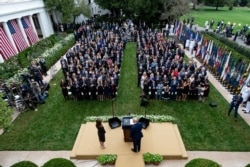After roaring through coastal cities in the spring, the coronavirus has now taken root in the mostly rural states of the upper Midwest, experts say.
This development marks the latest failure to control a virus that has claimed more than 212,000 lives, according to Johns Hopkins University data, or more than any other country and the third-highest death toll per capita.
For the past few weeks, sparsely populated North Dakota has led the nation in the number of new COVID-19 cases per capita, followed by South Dakota and Wisconsin.
As it did in major cities earlier in the year, COVID-19 now threatens to overwhelm these rural states' smaller health care systems.
Experts say the continued inability to control the virus is the result of a series of failures.
False sense of security
"Because [the outbreak] started in urban areas, people in rural areas felt safe. 'It's not in my neighborhood.' They were not as careful," said health metrics sciences professor Ali Mokdad at the University of Washington's Institute for Health Metrics and Evaluation.
Mask wearing has been consistently below the national average in places like North Dakota and Wisconsin, according to IHME. And mobility data shows people are less mindful of social distancing.
North Dakota's rural nature and relative isolation meant it took longer for the coronavirus to reach the state.
But the places where the virus spreads in rural areas are the same as in the cities: workplaces, bars, restaurants and other large, indoor gatherings.
"It's easy in a rural area to think that you see fewer people over the course of a day than in a city," said University of Southampton epidemiologist Nick Ruktanonchai. "But when you think about it in the context of the places where transmission actually happens," he added, there isn't much difference.
Failure to do the basics
From the beginning, experts have repeatedly stressed that in the absence of a vaccine, the only way to control the outbreak is with the basic tools of public health, including widespread testing for the virus, tracing people with whom they have been in contact and quarantining them so they don't infect anyone else.
But more than six months after the United States declared the coronavirus outbreak a national emergency, just eight states are doing enough testing to slow the spread of the virus, according to an analysis by Harvard and Brown Universities and NPR.
North Dakota and Wisconsin, for example, are doing roughly a quarter of the number of tests needed.
Congress passed a $3 trillion coronavirus relief bill in the spring, including some funding for public health agencies. But experts say contact tracing remains underfunded.
"If it were up to me," said Johns Hopkins Bloomberg School of Public Health epidemiologist Justin Lessler, "$500 billion of it would have gone to contact tracing."
Bought time, squandered
When states went into lockdown in the spring, "all we were ever doing was buying time," Lessler said. These measures don't eliminate the virus, but they aim to lower infection rates to let the health system catch up.
"If you do it long enough and bring cases down, you're going to get a do-over," he added.
For all the damage that coronavirus restrictions have done to the economy, Lessler hoped that officials would use the time to build up their testing, tracing and isolation capacity. That way, as they reopened society, they could handle the inevitable rise in cases.
"Clearly, we didn't do that, at least not at a national scale," he said.
Failure to think beyond the campus
Many communities went through heated debates this fall over whether to send students back to school or whether to keep them home and deliver classes virtually.
But many failed to consider how the virus was circulating in the surrounding communities.
"The debate shouldn't be about, 'Can I open my school?'" Mokdad said. "Yeah, you can open your school. But how long can you keep it open if you don't control the virus in your neighborhood?"
Some schools that brought students back for in-person learning had to close again shortly thereafter.
College towns became hotspots this fall for similar reasons. Many college campuses took measures to lower the chances of transmission in classrooms. But students only spend part of their days on campus. The virus spread in bars and at crowded parties, said Iowa State University statistics professor Lily Wang.
Her university "did whatever it can do for classroom control," she said. "But these parties, the majority of them are [off] campus."
Failure of leadership
The lack of a consistent, national strategy for tackling the virus has hampered the response, experts said.
"We need a national mandate for masks," Mokdad said. "It would save a lot of lives. It would have saved a lot of lives if we had done it in the past."
It's not clear whether a federal mask mandate would be legal. Democratic presidential candidate Joe Biden has called for a mandate for the use of masks on federal property, and he has called on state and local leaders to issue them.
President Donald Trump has, at best, given lukewarm support to wearing masks. Masks were conspicuously absent at a White House event when Trump nominated Judge Amy Comey Barrett for the Supreme Court. More than 20 attendees have tested positive so far.
Coronavirus containment strategies differ from state to state, and even between cities and states. Atlanta has clashed with the state of Georgia over mask mandates. Miami has different rules from the state of Florida.
"This has led to a lot of confusion," Mokdad said.
Mixed messages from political leaders have compounded the confusion, he added.
"Many voices out there were saying this is not a dangerous virus. It is going to go away. It's much less than a flu. There will be a miracle," he said, none of which are true.















